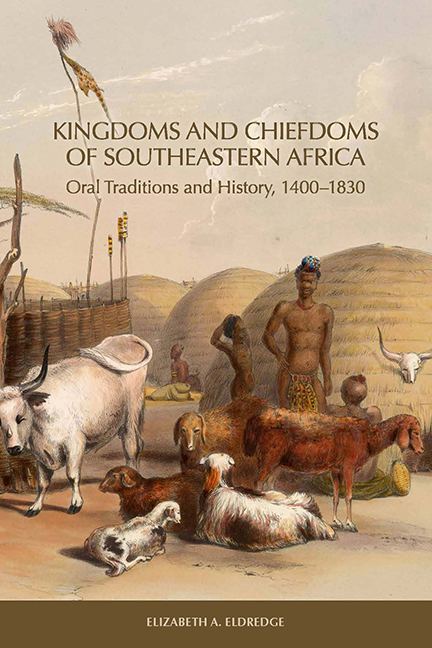Book contents
- Frontmatter
- Contents
- List of Illustrations
- Preface
- 1 History and Oral Traditions in Southeastern Africa
- 2 Oral Traditions in the Reconstruction of Southern African History
- 3 Shipwreck Survivor Accounts from the Sixteenth and Seventeenth Centuries
- 4 Founding Families and Chiefdoms East of the Drakensberg
- 5 Maputo Bay Peoples and Chiefdoms before 1740
- 6 Maputo Bay, 1740–1820
- 7 Eastern Chiefdoms of Southern Africa, 1740–1815
- 8 Zulu Conquests and the Consolidation of Power, 1815–21
- 9 Military Campaigns, Migrations, and Political Reconfiguration
- 10 Ancestors, Descent Lines, and Chiefdoms West of the Drakensberg before 1820
- 11 The Caledon River Valley and the BaSotho of Moshoeshoe, 1821–33
- 12 The Expansion of the European Presence at Maputo Bay, 1821–33
- 13 Southern African Kingdoms on the Eve of Colonization
- Appendix A Ama Swazi King Lists
- Appendix B Chronology of Conflicts, Migrations, and Political Reconfiguration East of the Drakensberg in the Era of Shaka
- Appendix C Interviewees from the James Stuart Collection of Oral Traditions
- Notes
- Bibliography
- Index
5 - Maputo Bay Peoples and Chiefdoms before 1740
Published online by Cambridge University Press: 14 March 2018
- Frontmatter
- Contents
- List of Illustrations
- Preface
- 1 History and Oral Traditions in Southeastern Africa
- 2 Oral Traditions in the Reconstruction of Southern African History
- 3 Shipwreck Survivor Accounts from the Sixteenth and Seventeenth Centuries
- 4 Founding Families and Chiefdoms East of the Drakensberg
- 5 Maputo Bay Peoples and Chiefdoms before 1740
- 6 Maputo Bay, 1740–1820
- 7 Eastern Chiefdoms of Southern Africa, 1740–1815
- 8 Zulu Conquests and the Consolidation of Power, 1815–21
- 9 Military Campaigns, Migrations, and Political Reconfiguration
- 10 Ancestors, Descent Lines, and Chiefdoms West of the Drakensberg before 1820
- 11 The Caledon River Valley and the BaSotho of Moshoeshoe, 1821–33
- 12 The Expansion of the European Presence at Maputo Bay, 1821–33
- 13 Southern African Kingdoms on the Eve of Colonization
- Appendix A Ama Swazi King Lists
- Appendix B Chronology of Conflicts, Migrations, and Political Reconfiguration East of the Drakensberg in the Era of Shaka
- Appendix C Interviewees from the James Stuart Collection of Oral Traditions
- Notes
- Bibliography
- Index
Summary
The chiefdoms of southern Mozambique were known by reference to the lines of descent of their rulers and were of longstanding existence by the time of the first arrival of Europeans. Like the chiefdoms to their south, they were not large enough to be considered kingdoms in accordance with how the term has been used in other regions of Africa, but their chiefs were called “kings” by the early Portuguese. The sociopolitical units of the southern Mozambique lowlands were considerably smaller than the contemporaneous well-known and much larger sociopolitical units of the Zimbabwe plateau and related cultures, which were kingdoms or empires with extended political networks involving tributary relations with subordinate chiefs. Modern references to the peoples of Maputo Bay have been largely determined by the observations and labeling of the Swiss missionary Henri Junod, but this has led to considerable confusion and difficulty because of the similarity of names of separate and distinct peoples in southern and northern Mozambique. To avoid confusion with the Tonga peoples of northern Mozambique, the southern culture and people have been referred to as Thonga or Tsonga, and the southernmost of these Tsongaspeaking peoples are referred to by Junod as “Ronga.”
The original ethnolinguistic designation “Tsonga” (Thonga or Tonga) in the Maputo Bay area was probably derived from the name of the early ancestor Mtonga. John Gama told Stuart, “the Tongas [southern Tsonga speakers] have for a very long period occupied the land they are at present living in. People after people have passed this part of the country from the north on the way to Zululand, Natal, Pondoland, etc., whilst the Tongas have remained stationary in Tongaland.” He continued with the explanation universally accepted among Ama Ngwane-Swazi descendants:
it was in the Tonga king Mtonga's reign that his (Mtonga's) brother Mswazi (the one listed among the names below Samukedi) came to occupy country along the base of or on the Ubombo mountains. The legend is this. Mswazi wanted to cultivate crops because he wanted food. Mtonga on the other hand wanted to hunt game. This was the origin of the separation, which was not due to a quarrel. Mswazi wished to fight with other peoples and obtain cattle, some of which were paid as tribute to his elder brother. Mtonga received these cattle, slaughtered and ate them.
- Type
- Chapter
- Information
- Kingdoms and Chiefdoms of Southeastern AfricaOral Traditions and History, 1400–1830, pp. 117 - 134Publisher: Boydell & BrewerPrint publication year: 2015

